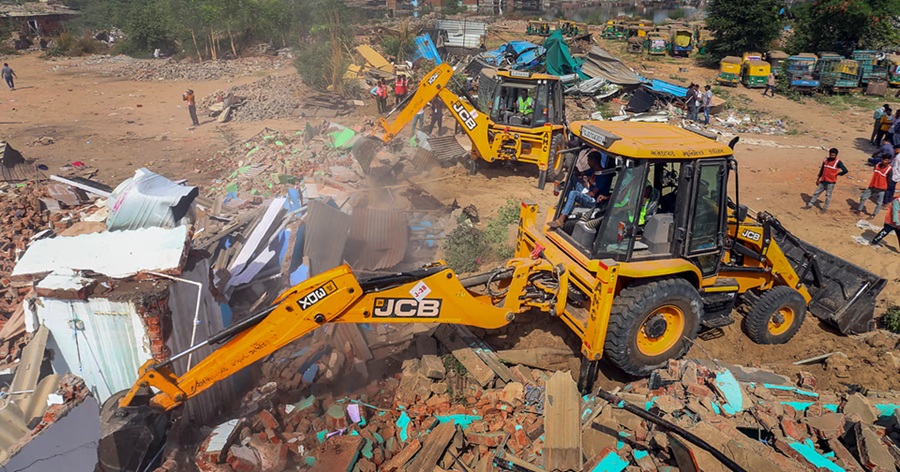In late April and May 2025, the Ahmedabad Municipal Corporation (AMC), backed by the city police and state reserve forces, launched large-scale anti-encroachment drives around Chandola Lake—an area colloquially known as “Mini Bangladesh” due to the high concentration of illegal settlements, many allegedly occupied by Bangladeshi nationals. Over two phases, authorities deployed some 3,000 police personnel, 60 bulldozers and dumpers, and cleared upwards of 4 lakh square metres of encroached land. While officials cite legal and security imperatives—ranging from preservation of a notified water body to countering illegal immigration—residents and rights groups decry a lack of due process, inadequate notice, and heavy-handed policing. The drives have sparked debates on “bulldozer justice,” communal profiling, and the balance between urban planning and human rights.
Background: Bulldozer Drives in Gujarat
The “Bulldozer Justice” Phenomenon
Over the past few years, several state governments in India have frequently used rapid demolition drives—dubbed “bulldozer justice”—to clear illegal structures, often in the wake of communal tensions or crimes. Critics argue these actions flout due process and target marginalized communities, while proponents see them as decisive urban enforcement tools.
Chandola Lake: A Historic Water Body under Siege
Chandola Lake, spanning some 1,200 hectares on Ahmedabad’s eastern flank, dates back centuries and serves as a crucial reservoir and recreational site. However, decades of unregulated growth saw tens of thousands of homes and shops spring up on its embanked shores, choking waterways and threatening both ecology and heritage.
Phase 1: April 29 Demolitions
On April 29, 2025, the AMC launched the first wave of its anti-encroachment operation, razing an estimated 1 lakh square metres of illegal huts and shanties near Chandola Lake. Authorities reported that over 2,000 huts were demolished, with 50 bulldozers and 50 dumpers in action, and some 2,000 police personnel overseeing the drive. Joint Commissioner of Police Sharad Singhal asserted that a majority of these settlements housed illegal Bangladeshi nationals, framing the operation as both urban enforcement and a national-security measure.
Security and Policing
To preempt any unrest, the city police deployed 2,000 officers and teams from the State Reserve Police (SRP), tightening cordons and conducting identity checks on site. In the days leading up to the drive, loudspeaker announcements urged occupants to vacate; those who had resided before 2010 were directed to apply for EWS housing schemes.
Phase 2: May 20 Intensification
Building on the perceived success of April’s actions, the AMC announced Phase 2 commencing May 20, aiming to clear another 2.5 lakh square metres of encroachments. Ahmedabad Police Commissioner G.S. Malik warned that any resistance would be met firmly but vowed to maintain law and order throughout. Nearly 3,000 police personnel and 25 SRP companies were slated to work in rotating shifts, with operations running from dawn and expected to last several days.
Rationale and Legal Framework
Protection of a Notified Water Body
Chandola Lake is a “notified” water body under Gujarat’s lake-protection laws, which bar any unauthorized construction on embankments or catchment areas. The Gujarat High Court has repeatedly upheld such protections, rejecting petitions against the drives.
Immigration and Security Claims
Police affidavits filed in the High Court alleged that the lake area harbored Bangladeshi nationals—and even individuals tied to an Al-Qaeda module—constituting a potential security threat. Surat Police’s “Operation Bangladesh” uncovered chat logs and contacts on seized phones, bolstering claims of a coordinated settlement network.
Human Impact and Controversy
Evictions and Livelihood Loss
Residents recount four-hour notices followed by swift demolitions that left families homeless within hours. Sangram Devipujak, a 65-year-old scrap dealer, saw his shop—50 m from a police post—razed with his belongings still inside. Many who proved their Indian citizenship only after detention voiced anger at the haste and lack of alternative housing support.
Legal and Rights Concerns
Rights groups argue that the drives lacked adequate due-process safeguards: eviction notices were too short, official records of property rights were ignored, and legal aid was virtually non-existent. Some petitioners approached the High Court, but relief was denied on grounds of the “greater public interest” in protecting the lake.
Political and Public Reactions
Government and Ruling Party
State leaders and BJP officials hailed the drives as necessary for urban renewal and national security, framing recalcitrant residents as “illegal infiltrators”. Gujarat’s Chief Minister praised the operation as a model for future anti-encroachment efforts.
Opposition and Civil Society
Opposition parties questioned the communal undertones, alleging that Muslim and economically vulnerable communities bore the brunt of these measures. Civil society groups called for more humane resettlement plans and judicial oversight, warning against setting a precedent of “might is right.”
Conclusion
Ahmedabad’s Chandola Lake bulldozer drives epitomize the tensions between urban governance, security concerns, and human rights in contemporary India. While municipal authorities emphasize legality, ecological restoration, and the removal of “anti-national” elements, the swiftness and scale of the demolitions have drawn criticism for sidelining due process and compassion. As Phase 2 unfolds through May 20 – 24 and beyond, the state faces the challenge of balancing robust civic action with equity, ensuring that the quest for urban order does not trample the rights of the very citizens it purports to protect.
